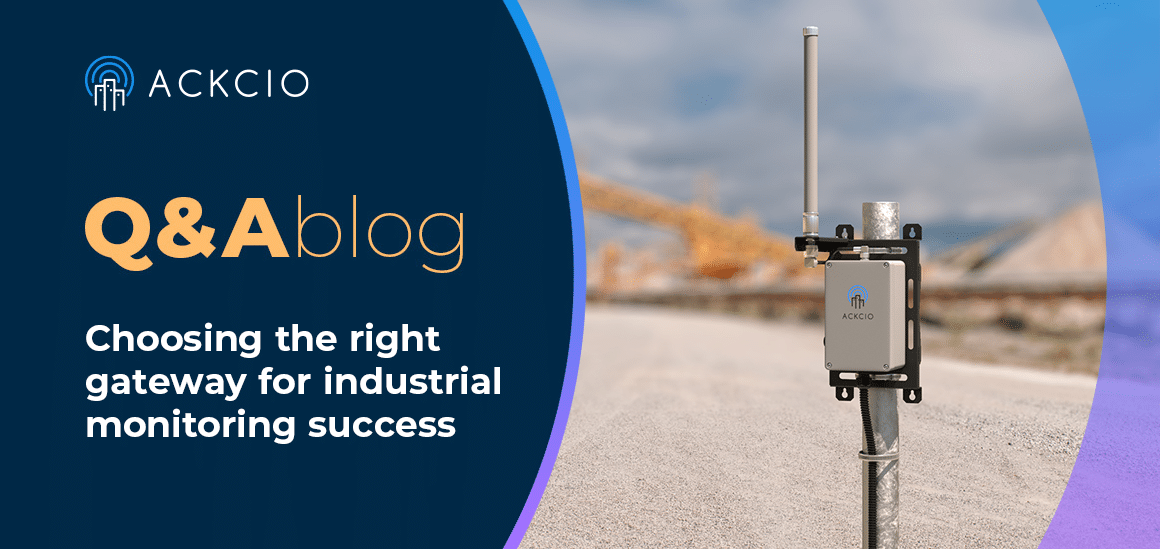Ackcio Mesh – A Reliable LPWAN Standard for Industrial Monitoring

Our world today has become increasingly connected, with every industry relying heavily on automation and digital transformation to survive and thrive. Connectivity plays a crucial role in this.
When it comes to IoT connectivity, there are quite a few technologies that we come across online. Words like LoRaWAN, Sigfox, and NB-IoT are familiar to most of us. In fact, we often use one or more of these technologies in our business for data collection, remote monitoring, or people tracking use-cases. Despite the differences in their underlying technologies, they all have one thing in common—a simple single-hop long-range communication capability from an end device to a centrally placed gateway. Using more technical jargon, we call them Star LPWANs (low power wide-area network).
There is a much more capable and feature-packed alternative—Ackcio Mesh, an interesting networking technology that allows for reliable, real-time, wireless monitoring especially catered for industrial applications.
Understanding LPWAN
LPWAN is a general term used to describe a radio technology, proprietary or nonproprietary, that provides long-range communication (up to 1km in urban environments and up to 5km in line-of-sight environments) while operating on small batteries for several years. As such, it offers an order of magnitude improvement in range compared to the other popular radio technologies, like Bluetooth, Wi-Fi, and ZigBee.
Despite being extremely constraint in the amount of data it can transmit at any given time, this technology is gaining traction across a range of industries. Companies like Sigfox and Semtech and captured a fair share of the LPWAN market and many more service providers are fighting for a slice of the IoT Pizza.
Sigfox
A French global network operator, Sigfox builds LPWANs to connect low-power devices (like electricity meters and smartwatches) that require small fragments of data to be periodically pushed to the internet. In some ways, Sigfox functions similarly to a telco; but one key difference is that it operates on a license-free sub-gigahertz radio frequency bands, like 433 MHz (China), 868 MHz (Europe), 915 MHz (Australia and North America), and 923 MHz (Asia).
Being a base-level LPWAN, Sigfox’s proprietary communication technology is limited and only able to transmit a maximum of 140 messages per day to the gateway. With each payload size of up to 12-byte, applications are fairly restricted. Downlink communication is also restricted with only four messages guaranteed to be transmitted on any given day.
Geographical range is another challenge. Although Sigfox is present in up to 70 countries, its usability is limited to regions where its connectivity has been deliberately extended—typically urban areas. But even here, the star topology of the network, obstructions, and other interferences can disrupt connectivity with the gateway.
LoRaWAN
LoRaWAN is another widely-used LPWAN that operates in the same unlicensed sub-gigahertz radio frequency bands as Sigfox. On the plus side, it does not require a fixed infrastructure by an operator, provides a considerably higher payload strength (up to 250 bytes), and can transmit an unlimited number of messages. Tests have shown an enormous range of communication in near ideal situations with a direct line of sight.
NB-IoT
NB-IoT is another promising LPWAN technology that is progressively being rolled out by many Telcos. Like Sigfox, it depends on an infrastructure maintained by network providers. While NB-IoT offers better performance in terms of reliability and higher uplink and downlink capacity, it consumes higher energy (roughly 3 to 5 times higher compared to other LPWANs like LoRa and Sigfox). This makes it less suitable for long-term battery dependent deployments.
Moreover, due to the dependence on fixed infrastructure, it is ill-suited for deployments in remote areas where the coverage is not yet established or not economically feasible for the telcos to setup. Even in urban environments, where the coverage exists, underground applications like tunnels or metro construction suffer.
Ackcio Mesh
Ackcio’s Mesh Network offers the same long-range communication as other LPWAN suppliers in the market but with certain key advantages. Our devices form a complex multi-hop mesh network to better route data around obstructions.
When compared with traditional 2.4 GHz mesh networks, Ackcio Mesh Network provides kilometers of range in every-hop, thus allowing for deployments in challenging environments like tunnels and large construction sites and mines.
Reliable
Ackcio Mesh allows redundant paths in the network to be utilized for data transmission. This prevents data loss due to obstructions, the creation of dead zones within the network, and allows a more distributed data storage for recovery. The complex multihop mesh networking architecture eliminates a single point of failure and makes the network more reliable.
Scalable
Ackcio Mesh is easily scalable. Not only adding new devices to the network is as easy as just turning them on, but also the addition of new devices to the network also creates many more pathways towards the Gateway and enhances the network coverage. This allows users to set up large network deployments without multiple gateways and allows perfect load balancing.
Resilient
The widespread adoption of LPWANs, as well as a lack of licensing, have made the sub-GHz spectrum increasingly saturated. This, in turn, leads to severe interference, enough to cause a reduction in bandwidth and an increase in latency. Ackcio Mesh uses multiple frequencies to avoid such interferences. By leveraging an industry-standard Time Synchronous Channel Hopping (TSCH) protocol, Ackcio Mesh transmits data using a different pseudo-randomly selected frequency, thereby avoiding repetitive transmission failure.
Self-healing
Building a Mesh networking protocol is a complicated task as is its deployment and maintenance. To simplify this process, Ackcio Mesh uses RPL, an industry-standard self-healing routing protocol. As such, the deployment process can be as simple as switching on the devices, and the software running on the devices automatically finds the best route to the nearest gateway.
Synchronized
Ackcio Mesh offers network-wide time synchronization down to a few milliseconds, allowing sensor data from different devices within a multi-hop network to be captured simultaneously. This is particularly beneficial to applications that require correlated readings from multiple sensors.
Energy-efficient
Ackcio Mesh sensors energy-efficient time-synchronized wakeups to exchange information reliably between adjacent devices with automatic time drift corrections and compensation to reduce the radio on time. The devices only wake up when they are supposed to and for a very small amount of time. As a result, they only draw close to 20µA current for over 99% of the time, making the devices last for years on batteries.
Bidirectional
Based on IEEE 802.15.4g and IPv6 industry standards, Ackcio Mesh offers multi-hop bidirectional links that allow users to reconfigure devices remotely and collect data on demand. The latter allows users to immediately verify whether an outlier reading is true or a false positive instead of waiting for the next scheduled data transmission.
Conclusion
Being a high-level LPWAN, Ackcio Mesh forms a primary component of Ackcio Beam, our state-of-the-art wireless monitoring system for geotechnical and structural sensors.
Thanks to its unique combination of advanced features, Ackcio Mesh facilitates the wireless transmission of data from remote sensors to our client’s fingertips in real-time, buying them valuable time and intelligence to make timely data-driven decisions. As such, Ackcio Mesh helps distinguish Ackcio Beam as the new industry standard for wireless monitoring applications.
Visit our main page to find out more about how we can advance the safety and stability of your infrastructure.


